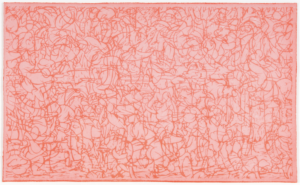After receiving his bachelor’s degree at the University of Tulsa (Oklahoma, United States, 1982), Herrera led a wandering life between New York, Venezuela and Europe. He later moved to Chicago where he pursued a graduate degree in Fine Arts at the University of Illinois (1992). He made his first collages in the late eighties and by the mid-nineties he had already developed a particular method for their preparation. Herrera cut figures from children’s coloring books, especially Walt Disney’s, used them as if they were ready-mades and combined them with drawing and painting in suggestive and disturbing sexually charged compositions. These collages were presented for the first time at the group exhibition The Sick Rose (The Drawing Center, New York, 1994). The game that took place between sexuality, child imagery and the breath of surrealism that permeated it, led to an initial interpretation of Herrera’s works in Freudian terms. However, further analysis suggested he was producing a body of work that revealed great ambivalence.
In 1994 he began to make murals, among the earliest was Tale (1995), a composition of tangled silhouettes of uncertain organic aspect. The viewer could not determine if what he was looking at were abstractions, a display of guts, or a jumble of Disney characters. The ambiguity which runs through Herrera’s entire work was not limited to these representative aspects. Despite being made with paint, the forms that populated his murals looked like large pieces of cutout paper glued to the wall. A sort of illusion was present in the many different levels of meaning that abounded in all the aspects of his works but especially in their materials and the technique itself. In 1998 he intervened with a painting the facade of the Whitney Museum of American Art in New York and created a mural, a tribute to Meret Oppenheim, at the College of Wooster Art Museum in Ohio (United States).
In the late nineties, Herrera produced pieces with cut felt shaped like poured ink or sandblasted paint that were actually installations but resembled drawings or drippings done directly on walls. All at Once and the series Behind the House, both from 1999, are early examples of these works. Following a similar principle, he produced a hybrid of painting and sculpture with cut MDF (medium-density fibreboard) shaped as blasted paint and covered with polyurethane. These objects were not to be placed on a wall despite being almost two-dimensional but on the floor, in the middle of the exhibition area, creating the illusion that that painting was coming out (Untitled, 1998). This work was followed by several series made of polyurethane on MDF, some were of irregular abstract forms to be placed directly on the wall (Untitled, 2000) and others were attached to a rectangular piece of MDF that served as their background (Untitled, 2004).
In some of the collages produced between 2002 and 2003 Herrera no longer cut the figures from children’s magazines but rather “drew them” with cutouts from various publications. These “drawings” (actually collages) were made from the remains of drawings or images whose themes could rarely be identified but contributed to the works with their lines and colors. In the series Night Before Last (2003), the cut shapes from monochrome papers not only corresponded to figurative drawings but also to large drippings that partially covered the works. Along with this series of collages, Herrera unveiled a set of preparatory drawings made of graphite on paper. In these works the drippings were silhouettes filled with graphite. Dripping paint, one of the most characteristic gestures of non-representational art is represented by the artist using different means through a complex process. For the series Keep in Touch (2004), Herrera hired professional illustrators to produce scenes from animated films which he cut and/or used as backgrounds. On the surface of these illustrations the artist made strokes with paint in an abstract expressionistic manner or adhered scraps of paper in the shape of paint strokes. Herrera insisted here on two recurring aspects of his work. On the one hand the viewer was able to detect glimpses from both films and cropped images while his imagination tried, often unsuccessfully, to identify and establish associations between them. On the other hand, through the rational, methodical and even symbolic use of an abstract expressionistic gesture, the viewer gave abstraction an intention that transcended both the optical and the random.
In the series Boy and Dwarf (2006) Herrera reached a new level of complexity in his characteristic mixture of materials and techniques, stratifying layers and sub-layers on the collage, leading to an experience of perceptions and associations of infinite appearance that is incomprehensible to the viewer. Thereafter, Herrera’s work has evolved in multiple directions using a variety of materials, media, techniques and themes. In the installation Les Noces (2007) he used video and digital media to establish a dialogue between the projected images of his earlier works and a ballet by Igor Stravinsky. In the collage Arabella (2012) an opera was the source of inspiration. More recently, Herrera has dabbled in the field of artists’ books. Intervening in common publications with various techniques and mixed media, occasionally using templates, the artist covers the pages of the books until the original content becomes barely visible or readable. The viewer feels that the rational message that was originally printed in the books has been made inaccessible due to the abstract or semi-abstract forms that occupy the foreground. It is clear that Herrera’s current works are characterized by a tension that has been present since the beginning of his career, in which more or less evident traces of representative forms are subverted by ambiguous and restrained gestural abstract form. It is important to note that Herrera has added a linguistic message to his repertoire in recent years.
For more information visit www.arturoherrera.org
